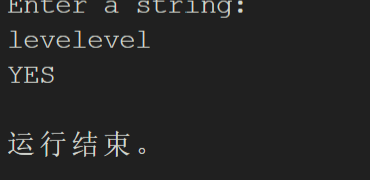实验六 指针
task1_1.c
#include <stdio.h> #define N 4 int main() { int x[N] = { 1, 9, 8, 4 }; int i; int* p; // 方式1:通过数组名和下标遍历输出数组元素 for (i = 0; i < N; ++i) printf("%d", x[i]); printf("\n"); // 方式2:通过指针变量遍历输出数组元素 (写法1) for (p = x; p < x + N; ++p) printf("%d", *p); printf("\n"); // 方式2:通过指针变量遍历输出数组元素(写法2) p = x; for (i = 0; i < N; ++i) printf("%d", *(p + i)); printf("\n"); // 方式2:通过指针变量遍历输出数组元素(写法3) p = x; for (i = 0; i < N; ++i) printf("%d", p[i]); printf("\n"); return 0; }

task1_2.c
#include <stdio.h> #define N 4 int main() { char x[N] = { '1', '9', '8', '4' }; int i; char* p; // 方式1:通过数组名和下标遍历输出数组元素 for (i = 0; i < N; ++i) printf("%c", x[i]); printf("\n"); // 方式2:通过指针变量遍历输出数组元素 (写法1) for (p = x; p < x + N; ++p) printf("%c", *p); printf("\n"); // 方式2:通过指针变量遍历输出数组元素(写法2) p = x; for (i = 0; i < N; ++i) printf("%c", *(p + i)); printf("\n"); // 方式2:通过指针变量遍历输出数组元素(写法3) p = x; for (i = 0; i < N; ++i) printf("%c", p[i]); printf("\n"); return 0; }

程序task1_1.c中,假设指针变量p初始值是地址2000,则执行++p后,指针变量p中存放的地址值 是多少?
2004
程序task1_2.c中,假设指针变量p初始值是地址2000,则执行++p后,指针变量p中存放的地址值 是多少? 都是对指针变量做++p操作,为什么结果不同?
2001 因为不同的指针变量类型对应所占字节数不同
task2_1.c
#include <stdio.h> int main() { int x[2][4] = { {1,9,8,4}, {2,0,2,2} }; int i, j; int* p; // 指针变量,存放int类型数据的地址 int(*q)[4]; // 指针变量,指向包含4个int型元素的一维数组 // 使用数组名、下标访问二维数组元素 for (i = 0; i < 2; ++i) { for (j = 0; j < 4; ++j) printf("%d", x[i][j]); printf("\n"); } // 使用指针变量p间接访问二维数组元素 for (p = &x[0][0], i = 0; p < &x[0][0] + 8; ++p, ++i) { printf("%d", *p); if ((i + 1) % 4 == 0) printf("\n"); } // 使用指针变量q间接访问二维数组元素 for (q = x; q < x + 2; ++q) { for (j = 0; j < 4; ++j) printf("%d", *(*q + j)); printf("\n"); } return 0; }

task2-2.c
#include <stdio.h> int main() { char x[2][4] = { {'1', '9', '8', '4'}, {'2', '0', '2', '2'} }; int i, j; char* p; // 指针变量,存放char类型数据的地址 char(*q)[4]; // 指针变量,指向包含4个char型元素的一维数组 // 使用数组名、下标访问二维数组元素 for (i = 0; i < 2; ++i) { for (j = 0; j < 4; ++j) printf("%c", x[i][j]); printf("\n"); } // 使用指针变量p间接访问二维数组元素 for (p = &x[0][0], i = 0; p < &x[0][0] + 8; ++p, ++i) { printf("%c", *p); if ((i + 1) % 4 == 0) printf("\n"); } // 使用指针变量q间接访问二维数组元素 for (q = x; q < x + 2; ++q) { for (j = 0; j < 4; ++j) printf("%c", *(*q + j)); printf("\n"); } return 0; }

程序task2_1.c中:
假设指针变量p初始值是地址2000,则执行++p后,指针变量p中存放的地址值是多少?
2016
假设指针变量q初始值是地址2000,则执行++q后,指针变量q中存放的地址值是多少?
2004
程序task2_2.c中:
假设指针变量p初始值是地址2000,则执行++p后,指针变量p中存放的地址值是多少?
2004
假设指针变量q初始值是地址2000,则执行++q后,指针变量q中存放的地址值是多少?
2001
都是对指针变量做++操作,为什么结果有差别?
因为p和q分别是二维数组的行指针和列指针,p++跳过一整行的空间,q++只是指向下一个位置
task3_1.c
#include <stdio.h> #include <string.h> #define N 80 int main() { char s1[] = "C, I love u."; char s2[] = "C, I hate u."; char tmp[N]; printf("sizeof(s1)vs.strlen(s1):\n"); printf("sizeof(s1) = %d\n", sizeof(s1)); printf("strlen(s1) = %d\n", strlen(s1)); printf("\nbefore swap: \n"); printf("s1: %s\n", s1); printf("s2: %s\n", s2); printf("\nswapping...\n"); strcpy(tmp, s1); strcpy(s1, s2); strcpy(s2, tmp); printf("\nafter swap: \n"); printf("s1: %s\n", s1); printf("s2: %s\n", s2); return 0; }

问题1:数组s1的大小是多少?13
sizeof(s1)计算的是什么?计算数据类型在储存空间中占用字节数
strlen(s1)统计的是什么?字符串的长度
问题2:line7代码,能否替换成以下写法?不能
问题3:line20-22执行后,字符数组s1和s2中的内容是否交换? 交换了
task3_2.c
#include <stdio.h> #include <string.h> #define N 80 int main() { char *s1 = "C, I love u."; char *s2 = "C, I hate u."; char *tmp; printf("sizeof(s1)vs.strlen(s1):\n"); printf("sizeof(s1) = %d\n", sizeof(s1)); printf("strlen(s1) = %d\n", strlen(s1)); printf("\nbefore swap: \n"); printf("s1: %s\n", s1); printf("s2: %s\n", s2); printf("\nswapping...\n"); tmp = s1; s1 = s2; s2 = tmp; printf("\nafter swap: \n"); printf("s1: %s\n", s1); printf("s2: %s\n", s2); return 0; }

问题1:指针变量s1中存放的是什么?字符串首字母地址
sizeof(s1)计算的是什么?指针变量s1有效字符所占的存储空间
strlen(s1)统计的是什么?s1所指字符串的字符长度
问题2:line7代码能否替换成下面的写法?不能
问题3:line20-line22,交换的是什么?字符串常量"C, I love u."和字符串常量"C, I hate u."在内存 存储单元中有没有交换?
交换的是指针所指的位置,没有
task4.c
#include <stdio.h> #include <string.h> #define N 5 int check_id(char *str); // 函数声明 int main() { char *pid[N] = {"31010120000721656X", "330106199609203301", "53010220051126571", "510104199211197977", "53010220051126133Y"}; int i; for(i=0; i<N; ++i) if( check_id(pid[i]) ) // 函数调用 printf("%s\tTrue\n", pid[i]); else printf("%s\tFalse\n", pid[i]); return 0; } // 函数定义 // 功能: 检查指针str指向的身份证号码串形式上是否合法。 // 形式合法,返回1,否则,返回0 int check_id(char *str) { int f= 1; if (strlen(str) != 18) return 0; for(;*str;++str) { if (*str >= '0' && *str <= '9' || *str == 'X') f = 1 ; else { f = 0; break; } } return f; }

task5.c
#include <stdio.h> #include <string.h> #define N 80 int is_palindrome(char *s); // 函数声明 int main() { char str[N]; int flag; printf("Enter a string:\n"); gets(str); flag = is_palindrome(str); // 函数调用 if (flag) printf("YES\n"); else printf("NO\n"); return 0; } // 函数定义 // 功能:判断s指向的字符串是否是回文串 // 如果是,返回1;否则,返回0 int is_palindrome(char *s) { int l; l=strlen(s); char *q; q=s+l-1; for(;*s;s++,q--) { if(*s!=*q) return 0; } return 1; }


task 6.c
#include <stdio.h> #define N 80 void encoder(char *s); // 函数声明 void decoder(char *s); // 函数声明 int main() { char words[N]; printf("输入英文文本: "); gets(words); printf("编码后的英文文本: "); encoder(words); // 函数调用 printf("%s\n", words); printf("对编码后的英文文本解码: "); decoder(words); // 函数调用 printf("%s\n", words); return 0; } /*函数定义 功能:对s指向的字符串进行编码处理 编码规则: 对于a~z或A~Z之间的字母字符,用其后的字符替换; 其中,z用a替换,Z用A替换 其它非字母字符,保持不变 */ void encoder(char *s) { char *p; p=s; for(;*p;++p) { if((*p>='A'&&*p<'Z')||(*p>='a'&&*p<'z')) *p+=1; else if(*p=='Z'||*p=='z') *p-=25; } } /*函数定义 功能:对s指向的字符串进行解码处理 解码规则: 对于a~z或A~Z之间的字母字符,用其前面的字符替换; 其中,a用z替换,A用Z替换 其它非字母字符,保持不变 */ void decoder(char *s) { char *p; p=s; for(;*p;++p) { if((*p>'A'&&*p<='Z')||(*p>='a'&&*p<='z')) *p-=1; else if(*p=='A'||*p=='a') *p+=25; } }





